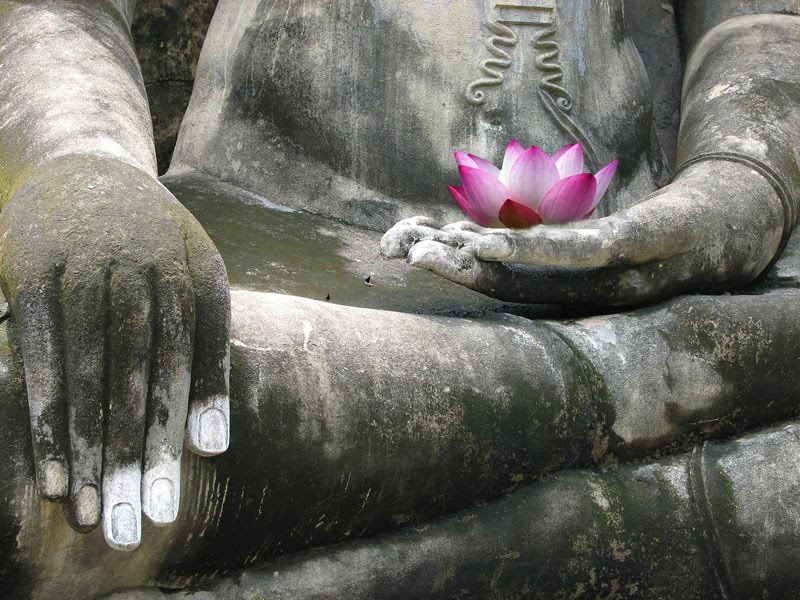Unlocking the Mystery of Om
Om (also written Aum) is the oldest and most sacred sound found in yoga, Hinduism and Buddhism. Om represents the entire universe, the source of all creation. Om represents all time: past, present, and future; and is beyond time itself. Om represents the eternal oneness of all that is, and thus represents the ultimate goal of yoga: to become unified in body, mind and spirit. Chanting the mantra Om is perhaps the oldest of yoga’s spiritual practices. Meditating on Om is used to guide one to discovering the higher Self, and the true nature of the universe. The Yoga Sutras of Patanjali instructs one in contemplating the meaning of Om as a direct path to enlightenment. “The repetition of the sound of Om, along with a deep contemplation of the meaning of what it represents, brings both the realization of the individual Self (Atman) and the removal of obstacles that normally block this realization” (Yoga Sutras 1.27-1.29).Om is said to be the essence of all mantras, and is used as the mula-mantra, the root and beginning of most mantras. Om is the bija (seed) mantra of the sixth chakra or third eye and chanting Om activates and opens this energy center. Om is also known as the adi-bija, the primary seed mantra. Om is used within sacred chants to increase their power and potency as well as to draw the practitioner into a deep internal state.
It is very important when repeating Om to pronounce the "O" sound correctly. In Sanskrit, the sound "O" is a diphthong-- a subtle speech sound that begins with one vowel and changes to another vowel within the same syllable. This “O” sound begins with an “A” sound as in “law” and ends with a “U” sound as in “put.” When these two vowel sounds are combined in this diphthong, it produces a single, pure vowel sound. Thus, when you pronounce Om it should sound like “home” without the beginning “h” sound. When pronouncing Om the sound should emanate from the navel, with a deep and harmonious vibration, and gradually rises upwards to resonate in the nostrils.When chanting Om, equal measure should be given to both the “O” and the “M” sounds, i.e. “oooommmm” and not “oommmmmm” or “oooooomm.” The mantra Om may be chanted aloud, whispered, or repeated mentally. The chanting of Om should be easy and natural, without strain. Usually when Om is chanted out loud it is long and when chanted mentally is it short, but experiment and do what feels most comfortable for you. When chanting Om you can also focus your gaze on the third eye center, the sixth chakra. If using Om as a mantra meditation you may wish to use a mala to count repetitions of 108.
The Power of Mantra
A mantra is a word or series of words chanted aloud or silently to invoke spiritual qualities. Chanting is used as a spiritual tool in virtually every cultural and religious tradition. In the yogic tradition, a mantra is a Sanskrit word that has special powers to transform mind, body and spirit. Translated, mantra means, “that which when reflected upon gives liberation.” Mantras are unique mystical formulas of sacred syllables, which were originally revealed to the Rishis (seers or sages) in the deepest states of meditation. Mantras were one of the earliest components of yoga and are quite possibly the first type of meditation that was developed.
The practice of chanting a mantra is considered the easiest form of meditation. Sitting in a comfortable position, with the eyes closed, the mantra is repeated silently or aloud. Pay careful attention to the speed and rhythm of your chanting, the correct pronunciation, aim, and esoteric meaning of the mantra. Allow the mind to be focused on the mantra, letting the thoughts go and maintaining a slow and deep breath. A mala (string of beads) can be used to count series of 108 repetitions of the mantra.Like prayer and affirmation, the repetitious use of mantra can have powerful effects on the mind, body, spirit and emotions. Mentally, mantra meditation increases concentration, and improves memory and focus. Physically, mantra meditation lowers the heart rate, reduces blood pressure, and activates the relaxation response to allow healing and rejuvenation to occur. Mantra meditation builds self-confidence and self-empowerment, reduces stress and balances the emotions. Spiritually, mantras are said to dissolve one’s bad karma, produce jnana (wisdom) and are considered one of the many yogic paths towards self-realization.
